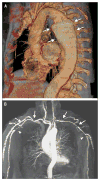Clinical practice. Giant-cell arteritis and polymyalgia rheumatica
- PMID: 24988557
- PMCID: PMC4277693
- DOI: 10.1056/NEJMcp1214825
Clinical practice. Giant-cell arteritis and polymyalgia rheumatica
Abstract
A 79-year-old woman presents with new-onset pain in her neck and both shoulders. She takes 7.5 mg of prednisone per day for giant-cell arteritis. Occipital tenderness and diplopia developed 11 months before presentation. At that time, her erythrocyte sedimentation rate was elevated, at 78 mm per hour, and a temporal-artery biopsy revealed granulomatous arteritis. The diplopia resolved after 6 days of treatment with 60 mg of prednisone daily. Neither headache nor visual symptoms developed when the glucocorticoids were tapered. How should this patient’s care be managed?
Figures


Comment in
-
Giant-cell arteritis and polymyalgia rheumatica.N Engl J Med. 2014 Oct 23;371(17):1653. doi: 10.1056/NEJMc1409206. N Engl J Med. 2014. PMID: 25337759 No abstract available.
-
Giant-cell arteritis and polymyalgia rheumatica.N Engl J Med. 2014 Oct 23;371(17):1652. doi: 10.1056/NEJMc1409206. N Engl J Med. 2014. PMID: 25337760 No abstract available.
-
Giant-cell arteritis and polymyalgia rheumatica.N Engl J Med. 2014 Oct 23;371(17):1652-3. doi: 10.1056/NEJMc1409206. N Engl J Med. 2014. PMID: 25337761 No abstract available.
References
-
- Weyand CM, Goronzy JJ. Medium- and large- vessel vasculitis. N Engl J Med. 2003;349:160–9. - PubMed
-
- Aiello PD, Trautmann JC, McPhee TJ, Kunselman AR, Hunder GG. Visual prognosis in giant cell arteritis. Ophthalmology. 1993;100:550–5. - PubMed
-
- Miller DV, Isotalo PA, Weyand CM, Edwards WD, Aubry MC, Tazelaar HD. Surgical pathology of noninfectious ascending aortitis: a study of 45 cases with emphasis on an isolated variant. Am J Surg Pathol. 2006;30:1150–8. - PubMed
-
- Kermani TA, Warrington KJ. Polymyalgia rheumatica. Lancet. 2013;381:63–72. Erratum, Lancet 2013;381:28. - PubMed
Publication types
MeSH terms
Substances
Grants and funding
LinkOut - more resources
Full Text Sources
Other Literature Sources
Medical
